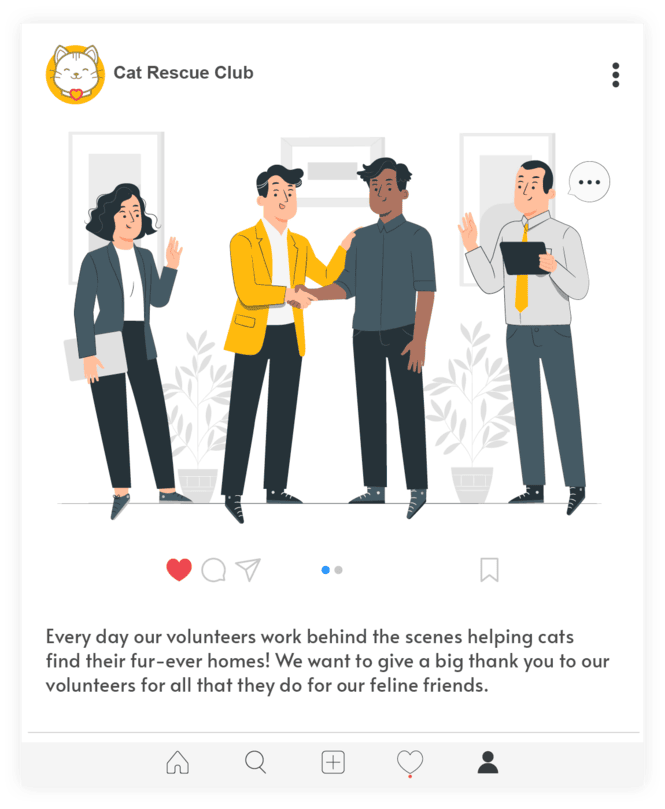Social media platforms like Facebook and Instagram are lifelines for nonprofits, connecting organizations with passionate supporters. People aren’t just scrolling. They’re discovering causes, sharing content, and taking action. Your next volunteer or donor could be one post away.
Social media is an unparalleled opportunity for your nonprofit to build lifelong relationships with tomorrow’s changemakers. To capitalize on these platforms, you need smart strategies.
Whether you’re new to social media or looking to improve your organization’s posting strategies, this guide will show you how to craft impactful content and engage your audience.
1. Share emotional stories about your mission.
Storytelling is crucial when promoting your nonprofit on social media. By sharing emotional, relatable narratives about who you serve or who supports your nonprofit, you connect real people to your work.
You might post a photo of one of your shelter’s rescued dogs with its new family, highlighting how donations provided medical care that made the adoption possible. Not only is this an effective form of donor recognition, but it could encourage others to donate as well. Or, you could post an interview with a volunteer who helped your disaster relief organization rebuild a house after a devastating fire, inspiring others to get involved.
Stories like these humanize your cause and inspire people to contribute, volunteer, or share your mission with their networks. Be sure to link your donation form or volunteer page. When telling stories, focus on these angles:
- Success: Share stories that highlight your nonprofit’s tangible impact and inspire hope.
- Urgency: Emphasize time-sensitive needs or situations to encourage quick action.
- Statistics: Use data to provide credibility and communicate the scale of issues your nonprofit addresses.
- Quotes: Bring authenticity to stories by including impactful quotes from beneficiaries or supporters.
- Humor: Lighten the tone when appropriate, using humor to make messages relatable and memorable.
Aim to include some form of storytelling in around four of every five posts. That way, you’ll post inspiring content and avoid coming across as overly promotional online. In contrast, if you ask for donations in every other post, followers might not engage with your content.
2. Incorporate powerful visuals into your nonprofit’s social media posts.
Facebook posts with images garner 2.3x more engagement, while posts on X (formerly Twitter) with images receive 150% more reposts. Meanwhile, social media giant Instagram is centered around photos and videos. This emphasizes a seismic shift away from written content and toward visual content as the primary source for social media engagement.
Getting Attention’s guide to Instagram for nonprofits encourages posting these types of visuals:
- Images that spotlight your mission, keeping your cause front and center (e.g., an environmental nonprofit sharing photos of natural landscapes or wildlife)
- Before-and-after photos that highlight the transformation of individuals or communities impacted by your programs
- Behind-the-scenes snapshots that give followers an inside look at your team in action
- Event recap photos that capture supporters’ energy for your cause
- Educational visuals like infographics to communicate key issues your nonprofit tackles
If you want people to share and like your nonprofit’s content, you need the necessary digital editing skills and photo libraries to produce solid content.
3. Producing high-quality graphics
Avoid using poorly designed images. On social networks, users will make snap judgments about your credibility based on your branding, which can be very good or very bad depending on the quality of your nonprofit’s designs. Ensure your graphics are high resolution, visually cohesive, and aligned with your brand’s colors and messaging to create a polished, professional look. Simple, clean designs with balanced spacing and readable text will make your visuals more effective.
Set your nonprofit up for success by investing in a professional graphic designer or design service. Having your avatars, banners, and backgrounds professionally designed will increase credibility.
4. Curate content from external sources
Many nonprofits find it challenging to create enough high-quality content to support a successful marketing strategy across multiple social media networks. That’s where content curation comes in handy.
Curating content involves finding and sharing relevant material from trusted external sources that align with your nonprofit’s mission. This can include articles, videos, infographics, and social media posts from partners, thought leaders, or industry organizations. By incorporating curated content into your strategy, you can fill content gaps, diversify your feed, and position your nonprofit as a valuable resource.
Here are actionable tips for effective content curation:
- Verify credibility. Only share content from reliable sources.
- Add context. Include a caption that ties the content to your nonprofit’s mission or programs.
- Make it personal. Use storytelling to humanize content. For example, pair an external article about community challenges with a success story from your organization.
When posted alongside your nonprofit’s original content, curated material can help your nonprofit maintain an impactful social media presence.
5. Post breaking news and current affairs related to your mission
Always be ready to respond to breaking news or current affairs related to your cause. Timely content related to viral news stories will generate high interaction rates.
For example, if your nonprofit focuses on disaster relief, you could post about the California wildfires, sharing updates on how your organization is responding and providing ways for supporters to help, such as donating.
A timely post like, “The Palisades Fire has burned over 23,000 acres and has devastated the L.A. community. We’re on the ground providing emergency aid. Here’s how you can make a difference today: [link to donation page]” is likely to see high engagement as it ties directly to current events.
6. Remember that people access social media on mobile devices
When distributing social media content, assume that most content is being viewed on a smartphone or tablet; therefore, study and understand how your content is displayed on mobile devices.
Explore what content displays well on both computers and mobile devices; this will positively impact your social media presence. Use large, easy-to-read text and keep graphic layouts clean. Tools like Canva or Adobe Express, which offer platform-specific templates, take the guesswork out of sizing graphics.
Consider shooting videos vertically. While people can rotate their mobile devices to view horizontal videos, a vertical format removes one step from engaging with your content. This is particularly important when posting to TikTok, Instagram Reels, or Facebook Reels, which encourage continuous scrolling.
7. Post to your nonprofit’s social media accounts consistently
Nonprofits that are active on social media will likely have higher follower numbers, engagement rates, shares, likes, and, most importantly, awareness! So remember that quality, consistency, and frequency are key when distributing social media content.
Develop a schedule for posting:
- Mission Updates: Share progress on initiatives, project milestones, or new programs to keep followers informed.
- Community Impact Stories: Post real stories from those who have benefited from your nonprofit’s work.
- Event and Campaign Announcements: Promote upcoming events, fundraisers, or awareness initiatives.
- Supporter Spotlights: Celebrate your volunteers and donors by highlighting their stories, contributions, and impact.

Each of these types of posts contributes to a well-rounded content strategy, bringing authenticity and trustworthiness to your social media presence.
8. Engage with your nonprofit’s social media followers
Social media offers two-way communication through features like comments, polls, and messages. By interacting with followers, you’ll encourage future engagement and build a community around your mission.
Try out these engagement opportunities:
- Respond to users. Like their comments on your page, comment on posts they tag your nonprofit in, and respond to messages to make them feel heard.
- Encourage birthday fundraisers. Supporters can celebrate their special day by rallying friends and family to donate to your cause. eCardWidget’s birthday fundraisers guide explains that you can launch these fundraisers directly on social media sites like Facebook, use an external peer-to-peer platform, or even sell birthday eCards on your site.
- Share user-generated content. Encourage followers to share their stories, photos, or experiences related to your nonprofit using a specific hashtag. Then, share these posts on your nonprofit’s social media page.
Thoughtful interactions demonstrate your appreciation and encourage supporters to continue engaging. By responding to users and sharing their content, you’ll create a loyal community eager to spread your message.
Social media is powerful for building meaningful relationships that drive real-world impact. Develop a content strategy that goes beyond mission updates and donation appeals, using the steps above as your foundation.



